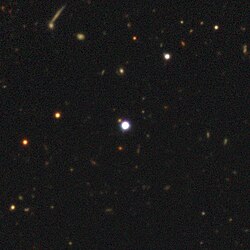Astronomy:BW Sculptoris
| Observation data Equinox J2000.0]] (ICRS) | |
|---|---|
| Constellation | Scuptor |
| Right ascension | 23h 53m 00.8742s |
| Declination | −38° 51′ 46.6625″ |
| Apparent magnitude (V) | 16.5 |
| Characteristics | |
| Evolutionary stage | white dwarf + brown dwarf |
| Spectral type | D+T[1] |
| Variable type | cataclysmic variable star |
| Astrometry | |
| Proper motion (μ) | RA: 81.036±0.043[2] mas/yr Dec.: -63.109±0.050[2] mas/yr |
| Parallax (π) | 10.6786 ± 0.0524[2] mas |
| Distance | 305 ± 1 ly (93.6 ± 0.5 pc) |
| Orbit[1] | |
| Primary | BW Scu A |
| Companion | BW Scu B |
| Period (P) | 78.23 minutes |
| Semi-major axis (a) | 0.58±0.02 R☉ |
| Inclination (i) | 64.3±3.6° |
| Semi-amplitude (K1) (primary) | 27.7±3.0 km/s |
| Semi-amplitude (K2) (secondary) | 461±13 km/s |
| Details[1] | |
| BW Scu A | |
| Mass | 0.85±0.04 M☉ |
| BW Scu B | |
| Mass | 53.4±6.3 MJup |
| Radius | 1.03±0.05 RJup |
| Other designations | |
RX J2353.0-3852, HE 2350-3908, 2MASS J23530086-3851465, MCT 2350-3908, TIC 183676876, AAVSO 2347-39 | |
| Database references | |
| SIMBAD | data |
BW Sculptoris is WZ Sge-type dwarf nova and a candidate period bouncer. The binary consists of a white dwarf and a brown dwarf donor that orbits the white dwarf every 78.23 minutes. BW Sculptoris is one of the closest and brightest cataclysmic variable stars with a brightness of magnitude16.5 and a distance of 93.3 parsecs. It also has the shortest period for any CVs known to date (as of August 2023).[1]
BW Sculptoris was discovered in 1997 by two teams. Abbott et al. discovered it with ROSAT as RX J2353.0-3852.[3] Augusteijn & Wisotzki discovered it independently in the Hamburg/ESO survey with the ESO 1.52 meter telescope and it was originally designated HE 2350–3908.[4] Both authors noted the low mass transfer.[3][4] Earlier mass ratios hinted at a low mass donor and Neustroev & Mäntynen were able to narrow down the mass of the white dwarf to 0.85±0.04 M☉ and the mass of the donor to 0.051±0.006 M☉ (53.4±6.3 |♃|J}}}}}}), making the donor a brown dwarf. BW Sculptoris is a candidate period bouncer. This is an evolutionary stage of a cataclysmic variable in which a donor star looses enough mass to evolve into a substellar object or brown dwarf. This occurs together with a decrease of the orbital period until the period reaches 70–80 minutes, at which point the period increases again. It is suspected that BW Sculptoris already passed this minimum and that the orbital period will increase in the future.[1]
Superoutburst of 2011
BW Sculptoris experienced a superoutburst with an amplitude of 7.5 mag in October 2011. The superoutburst was first detected by M. Linnolt (AAVSO) on October 21 with a visual magnitude of 9.6. On October 31 an ordinary superhump developed and on November 12 BW Sculptoris entered the rapid fading phase.[5] Even 10 years after the superoutburst the star has not returned to its pre-outburst level.[1]
References
- ↑ 1.0 1.1 1.2 1.3 1.4 1.5 Neustroev, Vitaly V.; Mäntynen, Iikka (2023-08-01). "A brown dwarf donor and an optically thin accretion disc with a complex stream impact region in the period-bouncer candidate BW Sculptoris". Monthly Notices of the Royal Astronomical Society 523: 6114–6137. doi:10.1093/mnras/stad1730. ISSN 0035-8711. https://ui.adsabs.harvard.edu/abs/2023MNRAS.523.6114N.
- ↑ 2.0 2.1 Gaia Collaboration (2020-11-01). "VizieR Online Data Catalog: Gaia EDR3 (Gaia Collaboration, 2020)". VizieR Online Data Catalog: I/350. doi:10.26093/cds/vizier.1350. https://ui.adsabs.harvard.edu/abs/2020yCat.1350....0G.
- ↑ 3.0 3.1 Abbott, T. M. C.; Fleming, T. A.; Pasquini, L. (1997-02-01). "The ROSAT cataclysmic variable RX J2353.0-3852.". Astronomy and Astrophysics 318: 134–139. ISSN 0004-6361. https://ui.adsabs.harvard.edu/abs/1997A&A...318..134A.
- ↑ 4.0 4.1 Augusteijn, T.; Wisotzki, L. (1997-08-01). "HE 2350-3908: a dwarf nova with a 78^m^ orbital period.". Astronomy and Astrophysics 324: L57–L60. ISSN 0004-6361. https://ui.adsabs.harvard.edu/abs/1997A&A...324L..57A.
- ↑ Kato, Taichi; Hambsch, Franz-Josef; Maehara, Hiroyuki; Masi, Gianluca; Miller, Ian; Noguchi, Ryo; Akasaka, Chihiro; Aoki, Tomoya et al. (2013-02-01). "Survey of Period Variations of Superhumps in SU UMa-Type Dwarf Novae. IV. The Fourth Year (2011-2012)". Publications of the Astronomical Society of Japan 65: 23. doi:10.1093/pasj/65.1.23. ISSN 0004-6264. https://ui.adsabs.harvard.edu/abs/2013PASJ...65...23K.
 |


